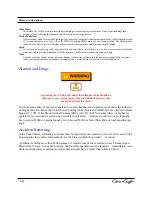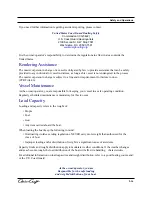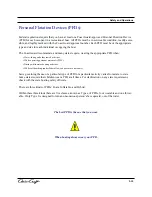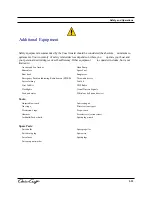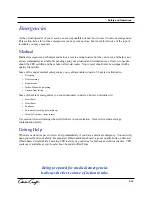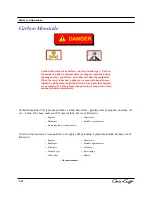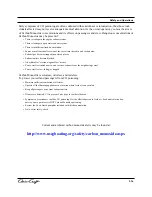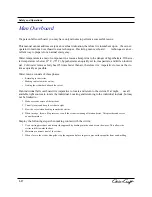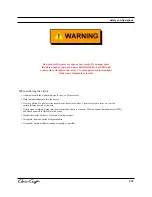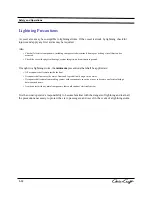
2-27
Safety and Operations
Man Overboard
If a person falls overboard, you may have only minutes to perform a successful rescue.
This manual cannot address every man overboard situation, therefore it is incumbent upon the owner/
operator to learn man overboard rescue techniques. Practicing man overboard techniques is an ex-
cellent way to prepare for an actual emergency.
Water temperature is a major component in a rescue attempt due to the danger of hypothermia. If the wa-
ter temperature is below 21° C (70° F), hypothermia can quickly set in, incapacitate, and kill an individ-
ual. Cold water removes body heat 25 times faster than air, therefore it is imperative to rescue the vic-
tim as quickly as possible.
Water rescue consists of three phases:
• Returning to the victim
• Making contact with the victim
• Getting the victim back aboard the vessel
If an individual falls overboard it is imperative to locate and return to the victim. If at night, use all
available light sources to locate the individual. Locating and returning to the individual include, but may
not be limited to:
1. Make everyone aware of the incident.
2. Visually locate and keep the victim in sight.
3. Slow the vessel when heading towards the victim.
4. When in range, throw a life preserver, even if the victim is wearing a flotation device. This provides and serves
as another marker.
Employ the following steps when making contact with the victim:
1. Use a circling procedure and attempt the approach by heading into the wind or into the waves. This allows the
victim to drift towards the boat.
2. Maintain a constant visual of the victim.
3. When close to the victim, alongside, stop the engine and place in gear to prevent the propeller from wind-milling.
Summary of Contents for 2014 36 RH Corsair
Page 19: ...Introduction 36 RH Corsair B...
Page 23: ...Safety and Operations...
Page 57: ...2 36 Safety and Operations...
Page 88: ...Figure 3 26 Fluid Tank Sensor 3 30 Systems...
Page 115: ...Care and Cleaning 3 57 Systems Marine Tops And Covers Care And Cleaning...
Page 116: ...Care and Cleaning Figure 3 51 Canvas Top 3 58 Systems...
Page 118: ...Care and Cleaning 3 60 Systems Maintenance and Cleaning Of Stainless Steel...
Page 121: ...3 63 Systems Grey Water Systems Figure 3 56...
Page 126: ...Figure 3 70 Figure 3 68 3 68 Systems Figure 3 66 Figure 3 67 Figure 3 69 Cockpit Table...
Page 134: ...3 76...
Page 149: ...Coast Guard Accident Report B 2 Appendix B...
Page 150: ...Coast Guard Accident Report B 3 Appendix B...
Page 151: ...B 4 Appendix B Coast Guard Accident Report...
Page 152: ...Coast Guard Accident Report B 5 Appendix B...
Page 154: ...C 2 Appendix C SPECIAL NOTICE TO MARINERS Float Plan...
Page 155: ...Appendix C C 3 Float Plan...
Page 158: ...Navigational Aids D 3 Appendix D...
Page 159: ...Lateral Aids D 4 Appendix D...
Page 161: ...Maintenance Log Forms E 2 Appendix E...
Page 162: ...Maintenance Log Forms E 3 Appendix E...
Page 163: ...Glossary Of Boating Terminology Appendix F F 1...
Page 164: ...F 2...
Page 165: ...F 3...
Page 166: ...F 4...
Page 167: ...F 5...
Page 168: ...F 6...
Page 169: ...5 7 F 7...
Page 170: ...F 8...
Page 171: ...F 8...
Page 172: ...G 1 Figure 4 21...
Page 173: ...G 2 Figure 4 22...
Page 174: ...G 3 Figure 4 23...
Page 175: ...G 4 Figure 4 24...
Page 176: ...G 5...
Page 177: ...G 6 Figure 4 26...
Page 178: ...G 7 Figure 4 27...
Page 179: ...G 8 Figure 4 28...
Page 180: ...Figure 4 29 G 9...



